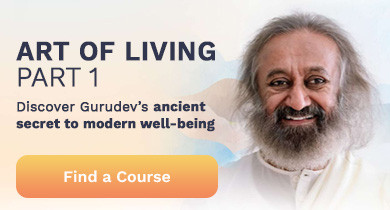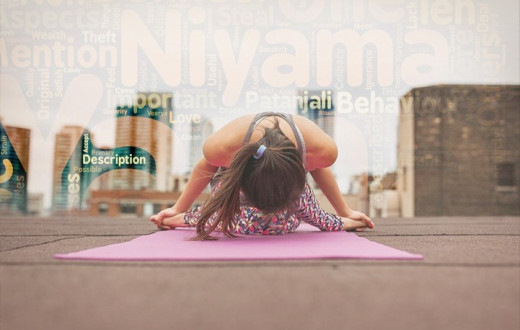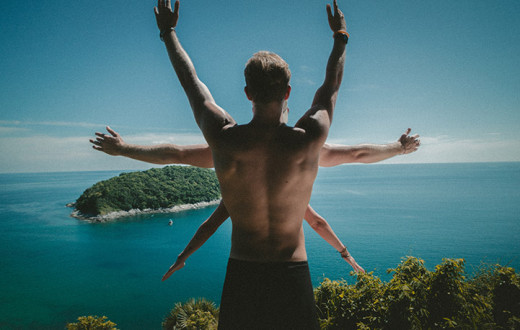Swimming is one of the only full-body workouts that burns calories without sweat. Not only does the sport require well-coordinated use of the entire body, but it also requires excellent lung capacity (unless you’re Michael Phelps, in which case superhuman lung capacity is required). Whether you swim for pleasure or are a professional athlete, chances are that you might encounter injuries at some point. While it is impossible to avoid injuries completely, taking precautionary measures to minimize their occurrence provides the best chance for prevention.
While swimming is a low-impact sport, the joints are not absolutely safe from injury. In fact, one of the most common swimming injuries, Swimmer’s Shoulder, occurs in the shoulder joint. Weakness of the rotator cuff and the muscles surrounding the shoulder blade can also occur. Besides the shoulders, hip, back, and knee injuries can all occur as a result of various kicks.
But not to worry! As with all sports, loosening the muscles helps minimize the possibility of injury, which is why yoga and pranayama are excellent additions to any swimmer’s daily routine. Practiced for more than two thousand years, yoga promotes the flow of synovial fluid in the joints, strengthens the muscles around the joints, and restores overused, tight, and inflamed muscles, thus providing athletes with the ability to protect their body from injury while simultaneously enhancing their performance.
The benefits of swimming include low-impact cardiovascular exercise and lowered risk of hypertension and stroke. Not to mention that swimming also helps tone the body and reduce excess fat. Yoga adds to these benefits by improving flexibility in the limbs and strengthening the back.
Swimmers require a lung capacity beyond that of any other athlete. In fact, studies show that intensive swim training results in the development of a wider chest, increasing the oxygen exchange within the lungs and increasing lung capacity. Due to the need for mass oxygen intake, practicing pranayamas can provide significant benefits for swimmers. Not only does breathwork expand lung capacity, but it triggers what is called the “relaxation response,” allowing athletes to enter a calm, focused state while performing at their best.
If you have never practiced yoga or pranayamas before, don’t worry! These simple yoga asanas and pranayamas are simple to learn and make an enormous impact when practiced regularly:
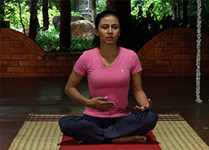
Kapal Bhati pranayama (Skull Shining Breathing Technique)
- Sit comfortably with your spine erect. Place your hands on the knees, palms open to the sky.
- Take a deep breath in.
- As you exhale, pull your stomach. Pull your navel in back towards the spine. Do as much as you comfortably can. You may keep your right hand on the stomach to feel the abdominal muscles contract. Pull the navel in.
- As you relax the navel and abdomen, the breath flows into your lungs automatically.
- Take 20 such breaths to complete one round of Kapal Bhati pranayama.
- After completing the round, relax with your eyes closed and observe the sensations in your body.
- Do two more rounds of Skull Shining breathing technique (Kapal Bhati pranayama).
The exhalation in Skull Shining Breathing Technique (Kapal Bhati Pranayama) is active and forceful. So just throw out your breath. Don't worry about the inhalation. The moment you relax your abdominal muscles, inhalation will happen naturally. Just keep your awareness on breathing out. Learn this technique from an Sri Sri Yoga teacher and then you can practice it at home on an empty stomach.
This pranayama improves blood circulation and energizes the nervous system. It also clears the nadi or energy channels in the body, thus aiding in better functioning of the body.
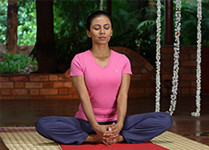
Baddhakonasana(Butterfly Pose)
- Sit with your spine erect and legs spread straight out.
- Now bend your knees and bring your feet towards the pelvis. The soles of your feet should touch each other.
- Grab your feet tightly with your hands.
- Make an effort to bring the heels as close to the genitals as possible.
- Take a deep breath in. Breathing out, press the thighs and knees downward towards the floor. Make a gentle effort to keep pressing them downward.
- Now start flapping both the legs up and down like the wings of a butterfly. Keep breathing normally throughout.
- Fly higher and higher, as fast as you comfortably can. Slow down and then stop. Take a deep breath in and as you exhale, bend forward, keeping the chin up and spine erect.
- Press your elbows on the thighs or on the knees, pushing the knees and thighs closer to the floor.
- Feel the stretch in the inner thighs and take long, deep breaths, relaxing the muscles more and more.
- Take a deep breath in and bring the torso up.
- As you exhale, gently release the posture. Straighten the legs out in front of you and relax.
Apart from being a good stretch for inner thighs and knees, this asana improves flexibility in the groin and hip regions.
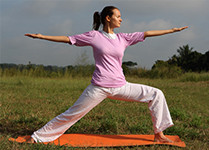
Veerbhadrasana(Warrior Pose)
- Stand straight with your legs wide apart by a distance of at least 3-4 feet.
- Turn your right foot out by 90 degrees and left foot in by about 15 degrees.
- Lift both arms sideways to shoulder height with your palms facing upwards.
- Breathing out, bend your right knee.
- Turn your head and look to your right.
- As you settle down in the yoga posture stretch your arms further.
- Make a gentle effort to push your pelvis down. Hold the yoga posture with the determination of a warrior. Smile like a happy smiling warrior. Keep breathing as you go down.
- Breathing in, come up.
- Breathing out, bring your hands down from the sides.
- Repeat the yoga posture for the left side (turn your left foot out by 90 degrees and turn the right foot in by about 15 degrees).
Warrior Pose strengthens the lower back and all four limbs, thus preventing injury and strain. It also releases stress from the shoulders and improves stamina.
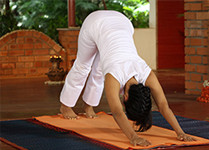
Adho Mukha Svanasana(Downward Facing Dog Pose)
- Come onto your fours. Form a table such that your back forms the tabletop and your hands and feet form the legs of the table.
- As you breathe out lift the hips up, straightening the knees and elbows, and form an inverted V-shape with the body.
- Hands are shoulder width apart, feet are hip width apart and parallel to each other. Toes point straight ahead.
- Press your hands into the ground. Widen through the shoulder blades. Keep the neck lengthened by touching the ears to the inner arms.
- Hold the downward dog pose and take long deep breaths. Look towards the navel.
- Exhale. Bend the knees, return to table pose. Relax.
This is an ideal asana for lengthening the spine, strengthening the chest muscles, and expanding the lung capacity. This inverted pose also helps in increasing the flow of blood to the brain, thus keeping headache, insomnia and fatigue at bay. It strengthens the arms, shoulders, legs, and feet – something that every swimmer needs.
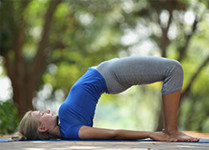
Setu Bandhasana(Bridge Pose)
- To begin, lie on your back.
- Fold your knees and keep your feet hip distance apart on the floor, 10-12 inches from your pelvis, with knees and ankles in a straight line.
- Keep your arms beside your body, palms facing down.
- Inhaling, slowly lift your lower back, middle back and upper back off the floor; gently roll in the shoulders; touch the chest to the chin without bringing the chin down, supporting your weight with your shoulders, arms and feet. Feel your bottom firm up in this pose. Both the thighs are parallel to each other and to the floor.
- If you wish, you can interlace the fingers and push the hands on the floor to lift the torso a little more up, or you could support your back with your palms.
- Keep breathing easily.
- Hold the posture for up to a minute, and exhale as you gently release the pose.
Setu Bandhasana relieves the tired back instantly. It also stretches the chest, neck and spine while strengthening the back muscles. Further, this asana opens the lungs and alleviates anxiety, stress and depression.
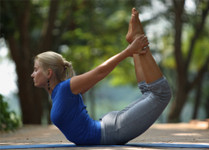
Dhanurasana(Bow Pose)
- Lie on your stomach with your feet hip-width apart and your arms by the side of your body.
- Fold your knees and hold your ankles.
- Breathing in, lift your chest off the ground and pull your legs up and back.
- Look straight ahead with a smile on your face. Curve your lips to match the curve of your body!
- Keep the pose stable while paying attention to your breath. Your body is now taut as a bow.
- Continue to take long deep breaths as you relax in this pose.
- After 15 -20 seconds, as you exhale, gently bring your legs and chest to the ground. Release the ankles and relax.
Dhanurasana is an excellent back-strengthening asana that also tones the muscles of all Four limbs. It also opens the chest, neck, and shoulders.
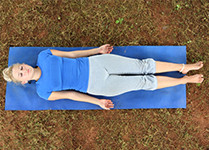
Shavasana (Corpse Pose)
- Lie flat on your back, preferably without any props or cushions. Use small pillow below your neck if absolutely required. Close your eyes.
- Keep your legs comfortable apart and let your feet and knees relax completely, toes facing to the sides.
- Place your arms alongside, yet a little spread apart from your body. Leave your palms open, facing upward.
- Taking your attention to different body parts one by one, slowly relax your entire body.
- Begin with bringing your awareness to the right foot, move on to the right knee (as you complete one leg, move your attention on to the other leg), and so on, and slowly move upwards to your head, relaxing each part of the body.
- Keep breathing slowly, gently, deeply and allow your breath to relax you more and more. The incoming breath energizes the body while the outgoing breath brings relaxation. Drop all sense of hurry or urgency or any need to attend to anything else. Just be with the body and the breath. Surrender the whole body to the floor and let go. Make sure you don’t fall asleep!
- After some time, about 10-20minutes when you feel fully relaxed, keeping your eyes closed, slowly roll onto your right side. Lie in that position for a minute or so. Then, taking the support of your right hand, gently sit up into a seated pose such as Sukhasana (Easy Pose).
- Keep your eyes closed and take a few deep breaths in and out as you gradually become aware of your environment and the body. When you feel complete, slowly and gently open your eyes.
This asana helps calm and harmonize the mind, while bringing deep rest to the body. Being a restorative asana, it can be practiced before and after your swimming session.
Swimming is perhaps one of the few waking experiences when we are completely cut off from the outer world and hear absolutely nothing. The brief tranquility that swimming provides calms the mind, releases stress, and uplifts the mood. This peaceful experience can be further enhanced by practicing meditation, which helps improve focus and break through mental boundaries while in a state of restful alertness.
Above all, it is important to provide the body with healthy, nutritious food and plenty of rest. Swimming is a physically demanding, full-body exercise that burns large stores of energy that must be refilled with wholesome, stamina-building food.
Overall, yoga, pranayama, and meditation equip athletes with a calm mind, increased stamina, and resilient body. To see the benefits of yoga in your swimming, make sure to include yoga in your daily routine, as results come with consistent practice!
